|
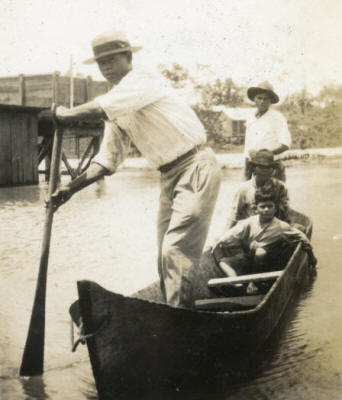 THIS IS THE SECOND PAGE
of documents for the FIRST HALF of 1931
on Nicaragua's Caribbean Coast
region, housing materials dated in the 44 days from February 16 to
March 31.
THIS IS THE SECOND PAGE
of documents for the FIRST HALF of 1931
on Nicaragua's Caribbean Coast
region, housing materials dated in the 44 days from February 16 to
March 31.
Chronicling the boldest, most
dramatic, and most popularly
remembered EDSN offensive
into the heart of the Caribbean
Coast, the documents presented here
and in the following pages offer an
unprecedentedly fine-grained
portrayal of Sandino’s most
intensive efforts to integrate the
Coast and Costeños into his
struggle. A series of
small-scale foraging raids &
robberies along the lower stretches
of the Coco feed into a swirl of
rumors about a big Sandinista
offensive in the offing (e.g.,
Lt. Benson, 21 Feb) — though even by
early March, Guardia intelligence
described the military situation as
“quiet,” punctuated only by “minor
disturbances on the COCO RIVER by
small group of outlaws” (3 March).
The last document on this page – an
eyewitness account of a Sumu Indian
from Musawas on the beheading of
Moravian missionary Otto Bregenzer
on 31 March by forces under Gen.
Pedro Blandón — is supplemented here
and on the following pages with
similar accounts of the incident,
which arguably became one of the
EDSN’s biggest strategic blunders on
the Coast, alienating untold numbers
of Costeños from Sandino’s cause.
Sandino himself was unequivocal
about his disdain for the Moravian
missionaries, as his Feb 21 letter
to Abraham Rivera makes clear.
The page includes four previously
unpublished missives by Sandino (21
Feb and 9, 16 & 25 March) that, when
read alongside the radiograms and
reports of the Marines & Guardia,
help to put these unfolding events
in a broader context. The
arrest & release of National
Assembly Deputy (and secret EDSN
General) Adolfo Cockburn also merits
close attention (12 & 16 March), as
does his connection to the
mysterious Henry L. Green (21 Feb).
Meanwhile across the Coast,
deteriorating economic conditions &
mass unemployment feed into a sense
of impending dramatic social
rupture, as illustrated in the
“revolutionary circular” found in
Puerto Cabezas (28 March) – a
circular entirely unrelated to the
EDSN, but emblematic of an
apocalyptic-millenarian sensibility
coursing throughout much of the
region’s social fabric, especially
nearest the largest export zones.
In
short, if there was ever a time
for a Sandinista
breakthrough on the Coast, this was
it.
|
|
PERIOD MAPS
|
|
1894 mosquito
shore

27 MB,
library of congress
|
1920s
Standard Fruit

6.5 mb,
US National archives
|
1928 Rio wanks
Patrol

3 mb, us
national archives
|
1931 Moravian

2.4 mb,
comenius press
|
|
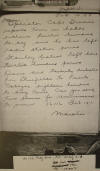
|
16 February
1931.
Report on outlaws in Cape Gracias,
Col. John
Marston, Bluefields.
"Operator
Cape Gracias reports town in hands
outlaws twelve hundred to-day and he has
left radio station period Stanley patrol
left here twelve hundred period Davis
and twenty enlisted from Bluefields to
Puerto Cabezas eighteen hundred to-day
period Can you send two planes for
reconnaissance to-morrow 16116 Feb 1931"
|
|
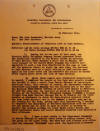
|
18 February
1931.
Establishment of temporary post at Cape
Gracias.
Col. John Marston, Bluefields, to
Jefe Director GN, p. 1.
"18 February
1931. ¶ From: The Area Commander,
Eastern Area ¶ To: The Jefe Diretor ¶
Subject: Establishment of temporary post
at Cape Gracias. ¶ Reference (a) My
radio message #17313 FEB 31 to JD ¶ (b)
Radio message #15316 FEB 31 JD to AC EA
¶ 1. During the latter part of last
week, the Tropical Radio Telegraph
Company became concerned about the
conditions reported to its Boston office
as existing at Cape Gracias (Cabo Gacias
a Dios) and on Sunday, the local manager
of the United Fruit Company was ordered
peremptorily to send a tug from
Bluefields to the cape to take off the
operator there. At about the same time,
the Governor at Cape Gracias sent me a
radio telling me that outlaws were again
on the lower river and had murdered six
people at Uluwas about eighty miles
above the town of Cape Gracias. ¶ 2.
While these rumors were discounted
considerably by myself, I realized the
people at the Cape were greatly alarmed
and decided to send a patrol from Puerto
Cabezas to investigate conditions there.
Upon receipt of orders, the Department
Commander dispatched Lieutenant Stanley
and ten enlisted men of the Guardia
Nacional from Puerto Cabezas at about
1300 Sunday 15 February. At 1400 the
same day, the operator on watch in the
Bluefields station of the Tropical Radio
Telegraph Company receive a message
relayed from Cape Gracias through the S.
S. Nicarao and the radio station at
Almirante in which the Cape Gracias
operator stated the town (Cape Gracias)
was in the hands of a bandit gang and he
was leaving for the bush. Acting upon
this information, I decided to reinforce
the Department of Northern Bluefields
with one officer and twenty men in order
to make an effort to destroy or capture
the outlaws raiding the lower Wanks
(Coco) River, and First Lieutenant Davis
and twenty enlisted departed from
Bluefields that afternoon. ¶ 3. I have
issued orders to the Department
Commander at Puerto Cabezas to exhaust
every means of making contact with the
group on the lower river. The news has
just reached this office that the
schooner “ULTRAMAR” upon which the
Bluefields detachment [...]"
|
|
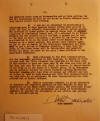
|
18 February
1931.
Establishment of temporary post at Cape
Gracias.
Col. John Marston, Bluefields, to
Jefe Director GN, p. 2.
"[...] -(2) - ¶
was embarked broke down at Prinzapolka
and at this writing the men are
proceeding by foot up the coast to
Puerto Cabezas where they should arrive
this evening. ¶ 4. I can see no
advantage in maintaining a temporary
post at Cape Gracias except during such
periods in which the town is actually
threatened by active outlaw groups. The
presence of these groups is usually
known well in advance (eighteen to
twenty four hours) and, if a schooner is
at Puerto Cabezas and the weather is not
too bad, a patrol can be sent to the
Cape in about ten hours. I believe if
the bandit group now reported to be on
the lower river below Sacklin can be
broken up in a sharp contact, few groups
will venture again so far to the
eastward. If the Department Commander
has been able to get a patrol to
Kisalaya promptly, I hope that the group
on the lower river will be intercepted
and possibly broken up. This, at least
is the plan I have outlined to the
Department Commander. ¶ 5. With
reference to the free transportation for
the temporary garrison at Cape Gracias,
it should be borne in mind that the
fruit steamers can land men at the Cape
only if the weather is good and then
only if the town can send out to the
ship and take the men off. This, of
course, is impracticable if the town is
in the hands of a bandit group. In an
emergency and in suitable weather the
fruit steamers leaving Bluefields
Saturday evening will take free of
charge any officers and men we desire to
land at Cape Gracias but this free
transportation is not available in an
emergency. No free transportation has
been offered out of Puerto Cabezas. ¶ 6.
Unless otherwise ordered, it is my
intention to withdraw the temporary
garrison at Cape Gracias as soon as
conditions on the Wanks River become
normal. The personnel situation in this
area is too precarious (in point of
insufficient numbers) to justify the
detachment of one officer and ten men
for an extended period. (signed) JOHN
MARSTON"
|
|
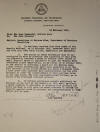
|
19 February
1931.
Desertions at Neptune Mine, Department
of Northern Bluefields.
Col. John
Marston, Bluefields, to Jefe
Director GN.
|
|
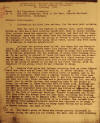
|
1.
20 February 1931.
Intelligence.
Capt. H. N.
Stent, Puerto Cabezas, to Col.
John Marston, Bluefields, p. 1.
(NOTE:
this report in the
TOP 100, Page 62).
Source:
NA127/43A/2d Brig B-2 Repts, 1 Jan-24
Mar 31.
"1. Information
elicited from natives, for the most part
reliable. ¶ That the raid of the
bandits in January last, under Abraham
Rivera as jefe was a mere scouting
expedition, made to secure information,
procure boats and supplies, get
recruits, and test out the Guardia
strength. Arms were also taken from the
Indians upon every possible occasion,
but it was not the policy of Rivera to
offer violence to the Indians or other
natives along their route, unless they
were known to be Marines or Guardia
sympathizers. ¶ At least two persons
were killed, one negro and one Mosquito
Indian, although most reports state four
persons killed, all of whom were either
negros or Mosquito Indians. These
killings were perpetrated by Timoteo
Altamirano who was sub-jefe of group
under Abraham Rivera. It was partly on
account of these killings that Rivera
and Altamirano disagreed. This
disagreement resulted in a fight between
Rivera and Altamirano, and the latter
with four of his friends were kicked out
of the group at Waspuk on the way up the
river. Rivera, with the remainder of the
group, about 30 men returned to Bocay.
¶ 2. Reports from
spies and Indians returning from up
river (Wanks) state that there are at
least 300 bandits, or rather outlaws, of
all nationalities in the Patuca river
section north of Awawas, and in the
vicinity of Kiplapini. They have a
regular outpost on the river near Awawas
situated so that it enables them to see
long distances both up and down the
river. These outlaws are a particularly
bad lot, are well armed, live by cattle
raising, and smuggling arms to the
people at Bocay. The outlaws in these
sections have no known jefe, although
all acknowledge Pedron and Sandino. Their raids are similar to the last one
made last September when Jose Lleset was
killed at Aguasbila, and are made more
with intention of murder, pillage and
private vengeance than in the form of
organized banditry. Timoteo Altamirano
was allied with them after his escape
from the Line here, following the
killing of a Sirian at Snaki on 22
January 1930. Timoteo Altamirano is a
relation of Pedron Altamirano, believed
to be a cousin. The outlaws from the
Patuca River-Awawas-Kiplapini section
are reported to be ready to join in
force the bandits group at Bocay under
Rivera for an attack on Puerto Cabezas,
the Cape or both. ¶ 3. The bandit
group at Bocay has become greatly
increased in numbers during the past six
(6) months. The main camp is some
distance ..."
|
|
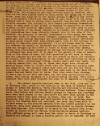
|
2.
20 February 1931.
Intelligence.
Capt. H. N.
Stent, Puerto Cabezas, to Col.
John Marston, Bluefields, p. 2.
"... up the Bocay
River. The reasons given by natives for
the increase in size of this group, are
that the concentrated drives by Guardia
and Marines in Segovia and Jinotega on
the bandit groups have caused many
desertions, and that many of these
deserters from the bandit ranks have
collected at Bocay. Abraham Rivera is
the only known Jefe, but alleges he has
been ordered there by Sandino, and that
he has been placed there to facilitate
the smuggling of munitions, arms and
supplies to the bandit groups in Segovia
and Jinotega. A deliberate effort has
been made to gain favor with the Bocay
Indians with a view to having their
support, and has met with considerable
success. The Indians in this region
professing themselves ready to take part
in any attack on Guardia or expedition
to Puerto Cabezas or Cabo Gracias. What
means, exactly, has been used to gain
the confidence of the Bocay Indians is
not known, but their feelings and
sympathies have been cleverly brought
over to the side of the bandits. The
presence of several foreigners in this
group has been reported; three of them
either Germans, Hungarians or Russians,
one American, and several Mexicans and
Honduranians. Indians unfriendly to,
this group report that some months past,
(due to the Indians inability to
describe time accurately, it is not
known exactly when, but between the
middle of September and October) a large
shipment of arms was brought up the
river in boats to Bocay from near
Awawas, having been previously smuggled
in through the Patuca river section. No
estimate has been able to be made of the
amount of arms or ammunition or the
class of arms, but that practically all
were in boxes, and the Indians did not
see but one box opened up which one
contained rifles. From the description
of the boxes some described as being
long and flat, (indicating) rifles,
others small and very heavy, indicating
ammunition, and two or three that might
have contained machine guns; there is
little doubt that the boxes did contain
arms and ammunition. The Indians state
that they did not see the boxes unpacked
at Bocay, but that they did see some
sent up the Coco River, toward Cua and
Santa Cruz in boats. They also state
that Abraham Rivera’s men do not have
new arms, nor are they particularly
well-armed, many having shotguns of a
muzzle-loading variety. This would
indicate that this arms shipment was
sent on to Segovia or Jinotega. ¶ 4. The latest
reports received came in the 14th, 15th
and 16th of February 1931, prior to the
details of the raid of Timoteo
Altamirano on Ulwas and Sacklin. These
reports are believed to be also
reliable, and have been obtained from
various Indians. These reports state
that Pedron and various bandit groups in
Segovia and Jinotega have been hard
pushed in the last drive and have been
placed in the position where they must
recoup in money, arms etc. or quit. The
successes they have planned and
anticipated with the previous reduction
in the Guardia were not realized, nor
have they been able to collect money in
the desired amounts from the coffee
planters in the interior. They have
planned a concentrated attack on Puerto
Cabezas and Cabo Gracias. This attack to
be made by the bandits from Bocay,
joined by others from the Patuca
river-Kiplapini-Awawas section. This
combined group will come down the river
in boats to Kisalaya or Sacklin and
attempt to draw a Guardia patrol out of
Logtown. If num- ..."
|
|
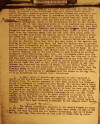
|
3.
20 February 1931.
Intelligence.
Capt. H. N.
Stent, Puerto Cabezas, to Col.
John Marston, Bluefields, p. 3.
" ...ber of group
is sufficient, part of them will
continue on down the river to Cabo
Gracias, sacking the Cape, and capturing
all available boats. If number is not
sufficient they will devote their
efforts toward drawing a guardia patrol
from Puerto Cabezas and wiping it out. The number this group will have is
estimated at from 200 to 250 men
including Indians. Reports very clearly
indicate that all boats are being
commandeered on the river and more are
being built. This group will march on
Logtown, which is the destination as far
as the informants know. All of this
described above is to be combined and
synchronized with a group, supposedly
under Pedron, coming over land through
Wani to vicinity of Tunky to Kukalaya
and hitting the Bragman Bluff Lumber
Companies new construction line near
Santa Cruz. There is a well cut trail
through the Kukalaya swamp from the new
line. This group plans on hitting the
New Line after the Guardia patrol which
the Sacklin patrol has drawn out, have
passed out of Logtown. Then this group
will push on into Puerto Cabezas,
commandeering all transportation and
robbing as they go. Reports state that
there are many spies of the bandits now
working on the railroad line here, and
that the bandits are in possession of
full information and all necessary
details. (Several suspicious persons
have been reported in Logtown during the
last 60 days) two of them foreigners
(Europeans). The bandits plan on having
their adherents in Puerto Cabezas, and
on the line attend to such details as
cutting telephone lines demolishing
radio etc. All informants state that
the bandits show surprising knowledge of
things along the line and in Port, and
that they have laid their plans
systematically and with care and that
everything gives signs of the bandits
having foreigners to advise and direct
them. The time of this joint attack is
stated as any time between the first and
middle of March, but the factor which
will determine it, will be the
conditions of the trails from Tunky
through the Kisalaya Swamp to the
railroad line. Informants do not know
whether the bandits plan on attempting
to raid the mines on the way over or to
go around them and conceal their
intentions. ¶ 5. A small group
of bandits was reported to have captured
a native on the Pis Pis trail about 15
miles from the end of the new railroad
line. The native supposed to have been
captured has disappeared and all
attempts to locate him have failed. The
captured man’s story was that there were
about 8 men in the bandit group and that
they kept him prisoner over night
questioning him as to when the next pay
on the line would be, and when the farms
on the new construction line would be
paid, also information concerning
commissaries etc. The man either escaped
or was permitted to go. No great
credence is placed in this report, due
to the fact that the motive cannot be
found. But it is a possibility and fits
in with the other information. The so
called bandits may very well have been
laborers discharged by the Bragman Bluff
Lumber Company. ¶ 6. The latest
information relative to the bandit
attack on Ulwas on the night of February
15th, is that there were seven (7) men
in the group, but that the jefe was not
Timoteo Altamirano, nor is it known who
the jefe was. They arrived at 1900 15th
at Ulwas from up the river. ..."
|
|
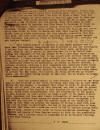
|
4.
20 February 1931.
Intelligence.
Capt. H. N.
Stent, Puerto Cabezas, to Col.
John Marston, Bluefields, p. 4.
"... Lieutenant
Benson, in his report received 19th
February, states that witnesses say the
bandit group were Honduranians, that
they were formerly employed on the
railroad line here at Brown’s Camp. They
did no material damage; no verification
of any killings done by them has been
received. They fired several shots,
stole $26.00 in cash, and scattered a
bag of flour over the ground. They left
Ulwas at 2300 February 15, went to
Saulala, and from there to Honduras by
trail on the 16th February. Benson
reports having thoroughly reconnoitered
Kisalaya, Waspam, Ulwas, Bilas Carmen,
Saupuca and Sacklin, and proceeding down
river by trail to Wasla and Kum. News
reached Lieutenant Benson from up river
concerning the four guardia deserters
from Neptune Mine, who have been
reliably reported as having passed
Waspuk 15th February, and gone up river
to Honduras. Benson will probably reach
Logtown tonight. ¶ 7. This latest
report of bandits on the Wanks appears
now to have been tremendously
exaggerated and distorted by all our
informants. I believe that our
informants have gained their ends,
partially at least, when we sent a
patrol to Cabo Gracias. It is my belief
that during the remainder of the dry
season we will have many repetitions of
these reports, and also that we may
expect more serious events than
heretofore. I firmly believe that
attempts will be made on commissaries
along the railroad line and perhaps on
the pay train, and very probably in
sufficient force to be successful. An
attack on Puerto Cabezas, I believe
unlikely, although a well commanded and
organized force could reach here without
detection during the dry season, and the
loot that they would get would be well
worth it. Particular pains are being
taken to protect the Pay train, the
Guardia car being protected by
boiler-plate, and the Guard strong
enough to make any, but an attack in
large force unsuccessful. ¶ 8. With the
present patrol in Cabo Gracias I believe
we can solve some of our troubles on the
river providing that they can be kept
there during the dry season. I recommend
that steps be taken to procure gasoline,
out of bond, for use at Cabo Gracias,
and that a boat be placed at the
disposal of the Guardia in Cabo Gracias
for periodic patrols up river. Under
these circumstances, with the
cooperation of the people in Cabo
Gracias, we could patrol at least a part
of the Wanks without undue expenses, and
thus gain timely information of bandits
on river, and perhaps obviate these
expensive expeditions which accomplish
little, and are inclined to make the
bandits laugh at our inability to catch
up with them. At present the expense of
hiring a boat with crew etc. for up
river is exorbitant, but had we the
gasoline free of duty, the boat rent
free, and a crew who could be fed by
Guardia during their time of duty,
(hence a civic crew) we could accomplish
something. The Governor and people of
Cabo Gracias should do this for the
protection afforded, and I believe could
be compelled to do so without stirring
up too much trouble. /s/ H N
STENT "
Thanks to
Pleet Initiative-funded Lebanon Valley
College student-researcher Nicholas J.
Quadrini for his transcription of this
document.
|
|
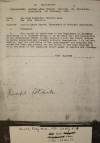
|
5.
20 February 1931.
1st Endorsement of Capt. Stent
Intelligence Report of 20 Feb.,
Col. John
Marston, Bluefields, 23 Feb., to
Jefe Director GN, p. 5.
"This report of conditions in the
Department of Northern Bluefields is of
interest though it is believed that the
description of the threatened attack on
Cabo Gracias and Puerto Cabezas is
purely conjecture and probably entirely
imaginative, I do believe, however, that
the activities of the "gun-runners" are
properly described and these may account
for the influx of new arms reported to
be in the hands of the organized bandit
gangs in Segovia and Jinotega."
|
|
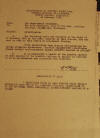
|
20 February
1931.
Intelligence Report,
Capt. H. N.
Stent, Puerto Cabezas, conveying
radio message from Cape Gracias via Lt.
Stanley.
"1. The
following radio was received on the
night of 17 February 1931 by the radio
operator at Cabo Gracias, and was sent
in code to this office by Lieutenant
Stanley: ¶ Jefe Sandinistas Cape
Gracias Radiografieme detalles ocupacion
aprovechen. (Garbled INALAMBRICO)
comuniarse prensa mundial fraternalmente
signed NORBERTO SALINAS DE AGUILAR."
¶ 2. It is apparently a result of the
rumored capture of Cabo Gracias by the
bandits. Salinas de Aguilar is
believed to be an ex-newspaper man
connected with Tijerino."
|
|
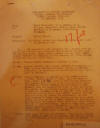
|
1.
21 February 1931.
Patrol Report,
1st Lt. W. W. Benson, Puerto
Cabezas, to Col. John Marston,
Bluefields, p. 1.
"21 February,
1931 ¶ Subject: Patrol Report. ¶
Reference: (a) Verbal orders from
Department Commander dated 16 February
1931. ¶ 1. In compliance with reference
(a) a patrol consisting of two (2)
Offices, thirteen (13) enlisted Guardia,
one (1) civilian guide, eight riding
animals and one pack animal cleared
LOGTOWN for KISALAYA at 0600 February
17, 1931. Events of each day are set
forth below: ¶ 16 Feb. Cleared PUERTO
CABEZAS for LOGTOWN at 2320. ¶ 17 Feb.
Arrived LOGTOWN 0400, cleared LOGTOWN
for KISALAYA at 0600, arrived KISALAYA
at 1645. Native of KISALAYA disclaimed
any knowledge of bandits activities.
Spent night in KISALAYA. ¶ 18 Feb.
Cleared KISALAYA for SACLIN and
intermediate towns at 0700. Passed
WASPAN at 0830. Arrived ULWAS at 0930.
Seven rebels, four of them Guardia
deserters from Neptune Mine and the
other three brothers named GONZALES from
SANTO DOMINGO, arrived ULWAS at 1925
February 15th and departed up river at
1945 same date. They robbed the
commissary of ABRAM MARTINEZ of $24.00
in cash and clothing valued at $102.30.
This group had stolen an outboard motor
from WASPUC, paddled silently down the
river and robbed the commissary. At 1945
they returned to their boat, started up
the river under power, and went as far
as SANTO DOMINGO the same night.
Approximately two hundred (200) shots
were fired through the roof of the
commissary. Departed ULWAS 1200, passed
SAUPUCA at 1430, passed BILWASKARMA at
1530 and arrived SACLIN1600. Dispatched
runner to WASLA and KUM for information.
Spent night in SACLIN. ¶ 19 Feb. 0300
runner arrived from LOGTOWN. 0900 runner
returned from WASLA and KUM with
information that all was normal in that
vicinity and that there had been no
bandits there. [...]"
|
|
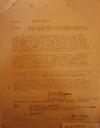
|
2.
21 February 1931.
Patrol Report,
1st Lt. W. W. Benson, Puerto
Cabezas, to Col. John Marston,
Bluefields, p. 2.
"[...] -2- ¶
Subject: Patrol Report ¶ 20 Feb. Cleared
SACLIN 0230 arrived LOGTOWN 1130.
Departed LOGTOWN 1330 arrived PUERTO
CABEZAS 1845. ¶ 2. This group of robbers
slipped down the river from WASPUC under
cover of darkness. They spent the day of
the robbery, February 15th, in a creek
about two hours paddling above ULWAS. On
the night of February 15th they left
their camp, paddled to ULWAS, robbed the
commissary, and returned up stream under
power. The Guardia deserters were in
uniform even to hat cords and escutas
and carried their rifles, belts and
bayonets. They stole only clothing and
cash. ¶ 3. It was ascertained that upon
our arrival in KISALAYA an Indian left
there and went to SANTO DOMINGO and
passed through WASPUC at 0300 February
18th taking the trail from there which
skirts the western side of CARATASCA
LAGOON and leads to the mouth of the
PATUCA RIVER. This information is
believed absolutely reliable. ¶ 4.
Although no empty shells could be found
in the vicinity of MARTINEZ commissary I
was reliably informed that they were of
the same type as our ammunition (Krag
Combat Ammunition). ¶ 5. The morale of
the Patrol was excellent. Upon our
arrival in KISALAYA none of us had been
to sleep for thirty-six hours and we had
walked approximately forty miles,
through a blazing sun with no rest
whatever. The only complaining from any
member of the Patrol was that we did not
obtain contact with the bandits. ¶
(signed) W. W. BENSON ¶ 1st Endorsement,
21 February 1931. ¶ DEPARTMENT OF
NORTHERN BLUEFIELDS, PUERTO CABEZAS,
NICARAGUA. ¶ From: The Department
Commander. ¶ To: The Area Commander,
Area of the East, Guardia Nacional de
Nicaragua. Bluefields, Nicaragua. ¶ 1.
Forwarded. (signed) H. N. STENT"
|
|
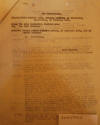
|
3.
21 February 1931.
Patrol Report,
1st Lt. W. W. Benson, Puerto
Cabezas, to Col. John Marston,
Bluefields, p. 3.
"[...] 1st
Endorsement. ¶ HEADQUARTERS EASTERN
AREA, GUARDIA NAIONALDE NICARAGUA, ¶
Bluefields, 23 February 1931. ¶ From:
The Area Commander, Eastern Area ¶ To:
The Jefe Director ¶ Subject: Patrol
report (BENSON patrol, 17 February 1931,
out of PUERTO CABEZAS. ¶1. Forwarded. ¶
JOHN MARSTON."
|
|
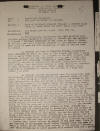
|
21 February
1931.
Case of military prisoner William C.
Chesser alias Henry L. Green alias Tom
Petty alias John Smith.
Capt. H. N.
Stent, Puerto Cabezas, to Col.
John Marston, Bluefields, p. 1.
|
|
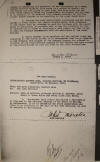
|
21 February
1931.
Case of military prisoner William C.
Chesser alias Henry L. Green alias Tom
Petty alias John Smith.
Capt. H. N.
Stent, Puerto Cabezas, to Col.
John Marston, Bluefields, p. 2.
|
|
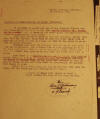
|
21 February
1931.
Statement of Miskitu Indian
Rosa Robinson
of Ulwas, Nicaragua, witnessed by Capt.
C. Darrah, Puerto Cabezas, Nicaragua.
"It is
known by myself and all of the Mosquito
Indians who are living along the Wanks
River, that Adolfo Cockburn is a friend
of the bandits, that he knows all of
their plans and expeditions etc. which
he keeps mostly under cover. ¶ With Abram
Rivera's group he was over friendly
Rivera told him, that he (Rivera) would
soon be down the river again with as
many men as there is rice in a bag, and
that he was going to go on to Puerto
Cabezas. ¶ Cockburn also told the Indians,
that if any of them notified the
authorities, that Sandino (who is also
planning to be on the next expedition)
when he was in command of the Port,
would have them all killed. They plan to
be back down the river some time in
March. ¶ Also there is a colored man who
all the people only know as doctor
living is Waspam, is connected with the
bandits. Bluffing the people by telling
them, he was appointed Governor of that
region by Rivera on his last trip down.
Is threatening the Indians every chance
he gets. ¶ Rivera had a large flag with
him on his last trip down the river, and
the following is a description of
same:-- ¶ A square in upper left corner w/
skull & cross swords. The rest of the
flag was red. ¶ /s/ Her Mark X Rosa
Robinson C. R. Darrah"
|
|
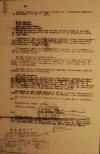
|
21 February
1931.
Letter from Gen.
Augusto C. Sandino to Gen. Pedro
Blandón (photocopy of original
unpublished letter taken from Gen.
Blandón's body).
"Cuartel General
del Ejército Defensor de la Soberanía
Nacional de Nicaragua. 21 de
Febrero de 1931. ¶ Señor General
Pedro Blandón, ¶ Campo de operaciones.
¶ Muy apreciable hermano: ¶ Fueron en
nuestro poder sus dos muy atentas notas
en las que se sirvio participarnos de
los combates y de su permanencia cerca
de 'Las Vegas.' ¶ Suponemos de que
ya habrá recibido nuestras otras
comunicaciones, inclusive la en que se
le ordenaba su inmediata reconcentración
a este Cuartel General, en unión de
nuestros hermanos Generales Pedro
Altamirano e Ismael Peralta.
¶ Ultimamente hemos tenido noticias de
nuestros dos hermanos Peralta y
Altamirano, de que salieron en la jira
de que con anterioridad Ud también
sabía. ¶ En esa virtud mi querido
hermano: Sírvase Usted con las
fuerzas a sus órdenes, pasar en el
termino de la distancia a este Cuartel
General de nuestro Ejército, en donde
recibirá nuevas instrucciones y parque
posiblemente para reforzar a esa
Columna. Nuestro hermano Francisco
Estrada, actualmente está curandose unas
ulceras en Honduras. Pués bién
hermano: El viaje de Ud con sus
fuerzas a éste Cuartel General de
nuestro Ejército, deberá de hacerlo por
el Campamento del hermano Capitán
Fulgencio Pérez. En los casos de
que Ud se encuentre por la Concordia,
Yalí, o San Rafael del Norte, sírvase
venir con sus fuerzas por los
Campamentos de 'El Ojoche' y desde allí
llegar por cordillera que esta
establecida, a este nuestro Cuartel
General. Suponemos de que sabrá
cumplir al pié de la letra, estas
instrucciones; pues en otro caso se hará
Ud responsable a las consecuencias.
Un sincero abrazo para todos nuestros
hermanos que le acompañan allí.
Sinceramente vuestro hermano, Patria y
Libertad /s/ A. C.
Sandino
P.D. Nuestro hermano el Sargento Mayor
Ladislao Palacios, permanece en 'El
Arco' con una fuerza armada de nuestro
Ejército, para establecer líneas de
comunicaciones, desde 'El Arco' hasta el
lugar denominado 'Los Araditos', el la
jurisdicción de la Ciudad de Estelí.
Vale. [Original document with seal.
Lt. WOOD, from body of Blandón.
RG127/38/30. See also IR31.05.01:
3-4, in RG127/43A/29]
|
|
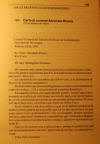
|
21 February
1931.
Letter from Gen.
Augusto C. Sandino, Cuartel
General del EDSN, to Sr. Cnl. Abraham
Rivera, Río Coco, p. 1.
"... La cuestión
de los sacerdotes en el Río Coco, y la
inclinación al hueveo de
nuestros muchachos. Posiblemente que
nosotros llegaremos a tener la
oportunidad de controlar militar, civil
y religiosamente a nuestra República.
En aquellos felices días para nuestro
pueblo, tendrá lugar entre nosotros un
análysis de todo lo que nos estorbe para
el progreso humano, y eso será barrido
por nosotros con escobas de bayonetas.
En esta vez me refiero a los sacerdotes
que están en el Río Coco. ..."
Published in Augusto C.
Sandino,
Pensamiento vivo, vol. 1
(Managua, 1984), p. 163.
|
|
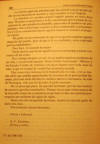
|
21 February
1931.
Letter from Gen.
Augusto C. Sandino, Cuartel
General del EDSN, to Sr. Cnl. Abraham
Rivera, Río Coco, p. 2.
Published in Augusto C. Sandino,
Pensamiento
vivo, vol. 1 (Managua, 1984),
p. 164.
|
|
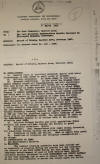
|
3 March
1931.
Excerpts from Record of Events, Eastern
Area, February 1931.
Col. John
Marston, Bluefields, to Jefe
Director GN, Managua, p. 1.
|
|

|
3 March
1931.
Excerpts from Record of Events, Eastern
Area, February 1931.
Col. John
Marston, Bluefields, to Jefe
Director GN, Managua, p. 2.
|
|
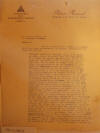
|
5 March
1931.
Telegram from
Pilar A. Ortega, Sub-Secretario
de la Ministro de Gobernación, Managua,
to Jefe Director GN, Managua, p. 1.
"Managua, 5 de
marzo de 1931. ¶ Sr. Jefe Director de la
Guardia Nacional. ¶ Presente: ¶ Para su
conocimiento y para que resuelva lo que
crea conveniente, me permit ranscribirle
el siguientge oficio: ¶ “PALACIO
NACIONAL.- Managua, D.N. 4 de marzo de
1931. – Senor Ministro: Para su
conocimiento y fines que juzgue
convenientes, me doy el honor de
transcriber a Ud. El siguiente oficio:
“Managua, 1o. de marzo de 1931.- Senor
Ministro.-: La persistencia de las
amenazas de partidas de bandoleros sobre
la ciudad de Cabo Gracias a Dios de que
varias veces he informado verbalmente a
Ud. Y que dieron lugar el envio de un
piquete de la Guardia Nacional para
proteger las vidas y las propiedades de
los moradores de aquel lugar, y el temor
de que la proteccion que esta fuerza del
Gobierno pueda cesar si el destacamento
se retirara, ha motivado que nuestra
oficina principal de Boston me haya dado
instrucciones para rogar la atencion de
Ud. A la necesidad de que el referido
destacamento no sea retirado y que
permanezca alla mientras las
circunstancia indiquen su necesidad.
Como Ud, bien sabe el gobierno al
celebrar con la Compania el contrato
para las instalaciones inalambricas le
exigio como una necesidad imperativa la
construccion de una estacion en el Cabo
Gracias a Dios, en interes solamente del
Gobierno como que los servicios que ella
prestaria serian exclusivamente para las
oficinas del mismo, dado que la escasez
de poblacion en aquel lugar no
justificaba una instalacion con fines
puramente comerciales. La fraccion final
de la Clausula VI del contrato de 6 de
agosto de 1921 dejo constancia de ello
al consignar: “Con el fin de abrir
comunicaciones con el Cabo Gracias a
Dios y en atencion a los ventajosos y
casi exclusivos servicios que la
estacion en ese lugar prestara al
Gobierno, permitira este. . . . .etc.”
Ahora la Compania tropieza con la
dificultad de asegurar a los operadores
de aquella es- [...]"
|
|
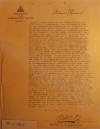
|
5 March
1931.
Telegram from
Pilar A. Ortega, Sub-Secretario
de la Ministro de Gobernación, Managua,
to Jefe Director GN, Managua, p. 2.
"[...] acion la
conservacion de sus vidas y de proteger
ella misma su instalacion, pues la
intranquilidad de los moradores de
aquella region, afligidos por la
persistencia de las noticias de que los
bandoleros aprovecharan la primera
oportunidad paa asaltar la poblaion y
echarse sobre la estacion y destruirla,
hace temer naturalmene que al alejarse
la proteccion ya suministrada por el
Gobierno, corren grave riesgos las vidas
de los operadores y las propiedades de
los particulares y principalmente los
extranjeros. Y no son de dudarse los
incalculable perjuicios que vendrian a
la Compania y sobre todo al Gobierno, si
llegara a hacerse imposible conseguir
operadores, o si la estacion fuera
destruida. Esto ultimo, sobre todo
concluiria definitivamente con el unico
medio de comunicaciones rapidas que
existe actualmene entre el interior de
la Republica y aquella region. Es por
eso que nuestra oficina principal me ha
dado instrucciones para rogar a Ud, una
especial consideracion del asunto, y
para pedirle que la proteccion sea
mantenida con la permanencia de un
desacamento de la Guardia en aquel lugar
suficiente para garantizar tanto la vida
de los operadores como la instalacion
radiografica, cuyo desmantelamiento si
la proteccion cesara, traeria
incalculable perjuicios a la Compania y
al Gobierno mismo. Y especialmene me
encarga preguntar a Ud, si puede
asegurar a su personal que debran cesar
sus temores, pues una declaracion del
Gobienro sobre el proposito de mantener
la proteccion ya acordada a nuestra
solicitud, calmaria la justa ansiedad de
los amenazados. Y anticipando a Ud, y al
Gobierno los agradecimientos de la
Compania y los personales mios por las
disposiciones que seguramente ha de
dictar en atencion a lo expuesto y por
la promesa de hacerlo que le ruego se
sirva trasmitirme, quedo respetuosamente
del senor Ministro su muy obsecuente y
seguro servidor, (f). Salv. Guerrero M.,
Representante de la Tropical Radio
Telegraph Company.- Al Senor Dr. Antonio
Flores Vega, Ministro de Fomento y Obras
Publicas.- S.D.”.-- Del Sr. Ministro con
muestras de mi mas alto aprecio y
distinguida consideracion, muy atto. Y
S.S., FERNANDO CORDOBA, Ministro de
Fomento por la ley.—Hon. Sr. Mtro. De
Gobcn., y Anexos, S.D.—“ ¶ De Ud. Atte.
Y S. S. ¶ (signed) Pilar A. Ortega ¶
SUB. SRIO. De la Gobernacion."
|
|


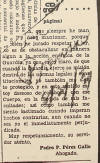
|
8 March
1931.
"Carta del doctor
Pedro Pérez Gallo al Jefe de la
Guardia Nacional de Bluefields sobre
derechos y garantías ciudadanas."
Newspaper clipping,
La
Prensa, Managua, 21 March
1931 (in three separate
images).
"CARTA DEL DOCTOR
PEDRO PEREZ GALLO …¶ Puerto Cabezas,
Marzo 8 de 1931, Senor Coronel John
Marston ¶ Jefe del Area del Este ¶
Guardia Nacional. Bluefields. ¶ Muy
distinguido Coronel Marston: ¶ Desde que
vine a ejercer mi profesion en esta
ciudad hace un ano, distintas vces he
tenido que llevar mis oficios ante los
jefes de la Guardia Nacional en defensa
de los derechos de ciudadanos que por
causas que no son necesario referir han
caido presos, por lo que recurren a mi
solicitando mis servicios profesionales.
¶ Con pena me he venido dando cuenta de
que tales jefes ven con desagrado que
tome la defensa de esas personas;
aunque,a decir verdad, caballeros como
el distinguido Capitan Mr. John C. Wood,
al fin y al cabo han reconocido que mi
actitud, en defensa de los derechos a mi
confiados, es nada hostil a los fines
que la Guardia persigue, sino como una
consecuencia logica de los derechos
legales que ejercito por mi profesion, y
por iguales derechos de las personas que
he defendido. Ultimamente, siempre en
ejercicio de mi profesion, he tenido que
llevar representaciones ante el actual
Jefe Capitan Mr. Herlen Pafley; y por
informes fidedignos que he tenido, y por
mi propia observacion, he llegado al
convencimiento de que soy ingrato para
el y que ve en mi actuacion obstruccion
a los intentos que persigue. ¶ Penoso es
para mi haber llegado a ese
convencimieno, porque vienen a mi
imaginacion dos ideas: o que los jefes
de la Guardia ignoran por completo el
alcance de nuestras leyes, o queriendo
irrespetarlas no admiten mas razon que
la que creen les asiste, con menos
precio irritante del derecho public que
ellos deben defender y apoyar. ¶ En los
ultimos dias de la semana que acaba de
pasar, he tenido que defender los
derechos de libertad de los senores
Guillermo Amaya, primero, y del Diputado
D. Adolfo Cockburn, despues. Tales
derechos fueron violados en la acepcion
estricta de la palabra, sin ponerme a
considerar quien es el infractor. ¶ En
el caso del Diputado senor Cockburn,
tambien me abstengo de comentarlo,
porque su prision fue un hecho que por
si solo clama contra los procedimientos
de las autoridades que intervinieron en
su arrresto; y si es que me veo en la
necesidad de citarlo, es para que se vea
que causa es la que he defendido, y no
se diga que me hago cargo de defender
hechos inmorales o a criminals vulgares
y detestables,y, que por aceptar esas
defensas, ello constituye para mi una
deshonra, por lo que deba merecer aun el
desprecio de las mismas autoridades ante
quienes lleve mis gestiones. ¶ Aun con
todo, Sr Coronel Marston, usted sabe que
el sagrado derecho de defensa, conquista
Hermosa de los derechos del hombre, no
se puede privar a ninguna persona, por
convicto que se halle de su culpa. El
Artifice Divino, y Legislador Supremo,
para castigar las dos primeras
infracciones cometidas en el mundo,
presto defensa a los infractores y
despues de haberlos oido dicto sus
sentencias inmutables. Y si la
Perfeccion Divina permitio defensa a los
culpable, no obsante que los hechos eran
de su pleno conocimiento, por que los
hombres, sujetos a errores y adictos a
querer cometer arbitrariedades, no han
de permitir tambien su defensa a los que
caen bajo la potestad de su autoridad? ¶
No dudo, Sr. Coronel Marston, que usted
ha de convenir conmigo, que las
autoridades muchas veces saltan los
diques de la ley y abusivamente se
lanzan soberbios contra los derechos de
los asociados. Entonces se hace
necesario la defensa de los oprimidos,
manifestando, siquera un gesto de
protesta, debil al parecer, pero fuerte
por el sustentaculo legal violado
abusivamene por la autoridad
desordenada. ¶ Entiendo que un pais en
donde no se permite el derecho de
defensa, ese pais ha pasado a la
categoria de pais en conquista, lo cual
repugna con las ideas modernas de la
epoca, ahora que la Democracia se
posesiona del mundo, y va recogiendo los
viejos pergaminos de gastadas noblezas,
y los blasones de las casta
privilegiadas , en cuyo movimiento,
tambien he querido creer, va a la
vanguardia la patria de Washington y de
Lincoln. ¶ Pero cuando he visto que en
el ejercicio de mi profesion he llegado
a la Oficina de los Jefes de la Guardia
de esta ciudad, y se me cierran las
puertas de las celdas donde estan
recluidos mis defendidos, alegandoseme
que estan incomunicados (con menosprecio
de terminantes disposiciones
constitucionales) francamente he sufrido
amargas decepciones, no por lo que a mi
respecta, sino al ver un derecho violado
y la Constitucion desgarrada en su
Majestad. Augusta Constitucion que he
querido ver en mi Patria con aire de
Soberana y con la voz de Pueblo libre
hiriendo implacable con su reproche mudo
pero vibrante la cara soberbia del mal
funcionario. ¶ Si las autoridades bajo
su mando procedieron dentro de los
limites de la ley, yo seria el primero
en respetar ese limite,como soy el
primero en protestar con el respeto y
comedimientos debidos, cuando veo que
ales autoridades no cumplen con el
juramento que prestaron de observar la
Constitucion y las leyes, y respetar los
derechos y las libertades del pueblo,
indudablemente sucede, porque no tienen
nociones de nuestro derecho publico,
como he dicho. ¶ Debe tener seguridad,
Coronel Marston, que en el ejercicio de
mi profesion y en defensa de los
derechos a mi confiados no quiero nada
gracioso de las autoridades, bien sean
del orden judicial o del adminisrativo;
y si tal cosa sucediera, tendria el mas
triste concepto del funcionario
inescrupuloso que, para congraciarse
conmigo, arrebatara el derecho de los
demas. Como tambien me molesta ver
funcionarios que quieren cubrir sus
maldades, y aun su venalidad,conel manto
de la ignorancia. ¶ Esta carta, senor
Coronel Marston, se concreta a pedirle
muy respetuosamente, que tenga la bondad
de hacer conocer a sus subalternos , en
esta ciudad, que (---) pleno derecho de
defender los intereses que se me
confien, mientras (---) sea merecedor de
la venia que (---) –tro mas alto
Tribunal de (---)—cia me ha concedido; y
que (---) actitud, dentro de los limites
(---) (---) que siempre he man-(---) y
debe mantener, porque si bien he jurado
respetar la ley, no es de obstaculizar
en manera alguna la accion energica de
la Guardia, ya que estoy claro, de que
cuando la Guardia ejerce su mision
dentro de las normas legales y
constitucionales, yo tambien me siento
protegido, y en este sentido estoy
deseoso de colaborar con ese Cuerpo, en
la medida de mis facultades; asi como
tambien me siento lastimado cuando
imperan hechos contrarios, aun cuando no
sea yo el inmediatamente perjudicado.
Muy respetuosamente, su servidor atento,
Pedro P. Perez Gallo, Abogado.--"
|
|
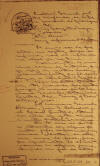
|
1. 9
March 1931.
Letter from Gen.
Augusto C. Sandino to Sgt. Major
Ladislao Palacios, El Arco, p. 1.
"Cuartel General
del EDSNN, 9 de Marzo de 1931.
Señor Sargento Mayor Ladislao Palacios,
'El Arco'. Muy apreciable hermano:
le envió con la presente, una cajita
parque de infume, para el rifle de esa
clase y que Ud tiene. Proximamente
le enviaremos parque de pistolas, pues
ya esta en nuestro poder y solamente
falta que los correos lleguen a este
Cuartel General. Toda la Costa
Atlántica, esta prendida por nuestras
fuerzas, al mando de los hermanos
Generales Altamirano, Peralta, Adán
Gomez, y Pedro Antonio Irias. Los
hermanos Generales Estrada, Juan G.
Colindres y el Coronel Quintero, están
por entrar con gente armada a nuestro
Cuartel General. En el case de que
Ud se entreviste con alguno de nuestros
jefes expedicionarios; sírvase solicitar
de ellos, una suma de pesos, para que
igualmente se sirva Ud procurar en
alguna forma, comprar un par de botas
..."
|
|
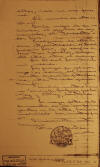
|
2. 9
March 1931.
Letter from Gen.
Augusto C. Sandino to Sgt. Major
Ladislao Palacios, El Arco, p. 2.
" ... altas, para
mi uso personal. En numero de
ellas es 38 1/2 o 39. Sería mejor
de que nos hiciera el servicio de
comprárnoslas, él 'Generalito' o
don Luis. Cualquiera de ellos podría
entrevistarse con el Coronel Joaquín
Lovo yo confío en esos tres hombres,
aunque ellos esten entre el enemigo.
El Coronel Lovo tiene mi medida.
Las fuerzas que salieron bajo las
ordenes del hermano Teniente Coronel
Perfecto Chavarría están teniendo
grandes triunfos. Tambien nuestro
hermano General Salgado, José Leon Díaz,
y Ortez han tenido exitos. La mayor
parte de los comisaritos de las
companias yankees en la Costa, han sido
incedidiados por nuestras fuerzas.
Sinceramente vuestro hermano, Patria y
Libertad /s/ A. C. Sandino
[Original document, 2 seals, excellent
condition, never before published.
NA127/38/30]
|
|

|
3. 9
March 1931.
Letter from Gen.
Augusto C. Sandino to Sgt. Major
Ladislao Palacios, El Arco, p. 3.
Guardia
transcription of letter. Captured by
Sgt. Ayala, 19 Jan. 1932 at Labranza.
|
|
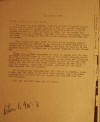
|
12 March
1931.
Letter from US
Legation (?), Managua, to
Minister of Gobernacion, Managua.
"12 March 1931. ¶
To the Minister of Gobernacion, ¶ In
answer to your inquiry relative to Senor
Diputado Suplente for the District of
Cabo Gracias a Dios don Adolfo Cockburn,
I have the honor to inform you that the
Jefe Politico of Bluefields received an
order on March 1, 1931, for the arrest
and deportation of Sr. Cockburn. The
Jefe Politico accordingly issued an
order, in writing, to the Jefe de la
Guardia, Bluefields, for the arrest. ¶
Upon receipt of that order the Jefe de
la Guardia, Bluefields dispatched an
officer of the Guardia to senor Cockburn
to escort him to Puerto Cabezas where he
was held. As soon as it was learned that
senor Cockburn was a Diputado Suplente
he was released. ¶ Senor Cockburn was
suspected of being in league with the
bandits and his activities at the time
of his arrest strongly pointed to
association with one Henry Green, an
American who illegally possessed a
pistol, stole two shotguns, another
pistol and some mules, and started for
the river openly stating he was going to
join the bandits. Green was pursued,
captured and has since been deported
from the country. It is positively
believed that the Jefe de la Guardia,
Bluefiedls, was not aware of the fact
that Cockburn was a Diputado Suplente
when the order for his arrest was
received from the Jefe Politico. With
all consideration, beg to remain, "
|
|
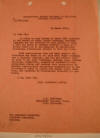
|
16 March
1931.
Letter from Jefe Director GN
Gen. C. B.
Matthews, Managua, to US
Minister, Managua.
"HEADQUARTERS
GUARDIA NACIONAL DE NICARAGUA ¶ MANAGUA,
NICARAGUA. ¶ 16 March 1931. ¶ My dear
Sir: ¶ In reply to your letter of March
13th relative to the arrest of Senor
Adolfo Cockburn, Diputado Suplente for
the District of Cabo Gracias a Dios, I
have the honor to enclose herewith a
copy of a letter submitted to the
Minister de Gobernacion containing
information similar to that you seek. ¶
This headquarters does not know whether
the President was aware of the fact that
Senor Cockburn was a Diputado Suplente,
and you are advised that as soon as the
Area Commander, Eastern Area, Guardia
Nacional, Bluefields, learned of
Cockburn’s congressional status and
radioed that information to Guardia
Headquarters requesting confirmation of
the President’s order to arrest and
deport senor Cockburn, the Minister de
Gobernacion directed his release. ¶ I
am, dear Sir, Very sincerely yours, ¶ C.
B . Matthews, Brigadier General, G.N.,
Jefe Director. ¶ TheAmerican Minister, ¶
American Legation, ¶ Managua."
|
|
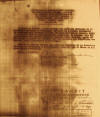
|
16 March
1931.
Credentials.
Gen. Augusto C.
Sandino, Cuartel General EDSN, to
Gen. Pedron Blandón, EDSN.
"CREDENCIAL DE
REPRESENTANTE PERSONAL DE ESTE JEFATURA
SUPREMA, A FAVOR DEL HERMANO JEFE
EXPEDICIONARIO DE NUESTRO EJERCITO,
GENERAL PEDRO BLANDON, EN JIRA MILITAR A
NUESTRA COSTA ATLANTICA. El
suscrito General y Jefe Supremo del
EDSNN, extiende la presente Credencial
de Representante Personal de est
Jefatura Suprema de nuestro Ejército, en
la jira Militar a la Costa Atlántica, al
hermano Jefe Expedicionario de nuestro
Ejército, General Pedro Blandón, quien
va facultado a ponerse en contacto con
las personas que simpatizen con nuestra
lucha Libertadora en Nicaragua.
Dado en el Cuartel General del EDSNN, 16
de Marzo de 1931, PATRIA Y LIBERTAD /s/
" [original document w/
seal. Taken from body of Blandón by
Capt. Wood. NA127/38/30]
|
|
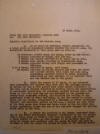
|
18 March
1931.
Conditions in the Eastern Area.
Col. John
Marston, Bluefields, to Jefe
Director GN, Managua, p. 1.
|
|
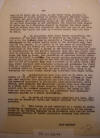
|
18 March
1931.
Conditions in the Eastern Area.
Col. John
Marston, Bluefields, to Jefe
Director GN, Managua, p. 2.
|
|
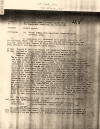
|
1.
22 March 1931.
Patrol Report,
2nd Lt. Leonard Curcey, El Gallo,
to Col. Marston, Bluefields, p. 1.
"From: ¶ Second
Lieut. (TEMP) Leonard Curcey, GN.¶ To:
The Department Commander, GN,
Bluefields. ¶ Subject: Patrol report. ¶
Reference: (a) Verbal Orders from
Department Commander dated 15 March,
1931. ¶ 1. In compliance with reference
(a) a patrol consisting of two Officers,
twenty (20) enlisted guardia, two (2)
civilians, and four (4) pack animals
cleared EL GALLO for Prinzipolka at 0930
March 15, 1931. Events of each day are
set forth below:- ¶ 16 Mar. Cleared El
Gallo for Tungla and immediate Hamlets
at 0930. ¶ 18 Mar. Arrived at Tungla
1900. Spent night there and the next day
obtaining all possible information as to
whereabouts of bandits, Information
obtained is as follows:- ¶ “On or about
1230 March 1, 1931 a Bandit group of
about one hundred and sixty (160) men
under the leadership of PEDRO ALAMIRANO,
of which only half of them were armed
with rifles, four machine guns, little
ammunition and the rest with machetes,
entered the town of TUNGLA, They left at
or about 1630 and camped two hours
outside of Tungla on the road to
Cuicuina and from there they left for
Cuicuina with their destination
Cuicuinita, Quepi, Isla Grande and to
San Pedro, On the Rio Gande. They robbed
a Mr. Lawrence Newball (Creole), Juez de
Mesta Steven Budeara, Alvira Valles, and
Sebastian Jiron. Mr. Newball was
operating a small store in which he had
about Three Hundred ($300.00) dollars
worth of groceries and other articles
and the other people mentioned suffered
the loss of their personal clothing,
shoes and trinkets such as gold finger
rings and gold necklaces, Mr. Lawrence
Newball and the Juez de Mesta mentioned
a woman, known as Patricia Moncada, who
at one time lived in Tungla and because
of her conduct and petty robberies was
forced to leave the town, as the woman
who instigated and persuaded PEDRON and
his gang to go to Tungla as there were a
lot of rich inhabitants and a few stores
and that their trip would be well worth
it. Mrs. Patricia Moncada can now be
located in Siuna. ¶ 2. The following is
a list of names of people who live in
JINOTEGA were PEDRO ALTAMIRANOS group:-
Lino Rizo, Candelario Altamirano
(Pedron’s brother), Pablo Vilche, Ramon
Martinez, Pedro Irias, Abraham Rivera, ¶
Mr. Lawrence Newball further states that
while Pedron and his gang occupied the
town on March 1, 1931 they heard a
gasoline motor boat coming up the river
and that Pedron got his men together and
ordered them to get ready to leave at
[...]"
|
|
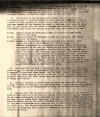
|
2.
22 March 1931.
Patrol Report,
2nd Lt. Leonard Curcey, El Gallo,
to Col. Marston, Bluefields, p. 2.
"[...] once that
the guardias are coming up. It is very
evident that he is not very anxious to
make contact, that his robberies are
only made at places where he meets no
resistance that he is short of
ammunition. Mr. Lawrence Newball also
states that Pedron and his band are not
looking for anybody except Machos,
Machistas, President Moncada,
Ex-President Adolfo Diaz and Emiliano
Chamorro. ¶ 3. The Captain of the
Gasoline boat running from the mouth of
the Prinzipolka river to Cuicuina
informs me that there are no bandits at
all at Cuicuina and that reports and
rumors he got there are that Pedron and
his band were headed for the interior
via trail to Matiguas on or about 12
March, 1931. He also states that the
number of unarmed men traveling with
Pedron were headed back toward the
interior with loot using pack animals
and men. ¶ 20 Mar. Cleared Tungla for
Savannah at 0630 and arrived at 1530
camped there for the night. ¶ 21 Mar.
Cleared Savannah for Sixiquas and 0630
and arrived at 1730 camped there for the
night. ¶ 22 Mar. I and two enlisted
Guardias proceeded down Sixiquas Creek
toward mouth of it which empties into
the Rio Grande to a Mr. Molinero where
there is a telephone and called Captain
Shaughnessey and reported to him that
the trails for San Pedro via Pal Punta
were all closed in and impassable, that
they had not been travelled any in five
or six years. That the mules (pack
animals) I had were in pretty bad shape,
including three members of the patrol,
and that I could not continue via trail
but suggested that I go by river in
boats after the pack animals and the
three members of the patrol had been
sent back to El Gallo. The Captain
directed me to get entire patrol to
mouth of Sixiquas creek that he would
arrange to have company boat come for
us. Arrived El Gallo at 1230 March 22,
1931. ¶ 4. The trail from Muy Real to
Savannah is in very bad shape, the first
day patrol had to cut its way through
almost half the way. The second day
trail on savannah was in excellent shape
except that no trail along Prinzipolka
river to TUNGLA and there again we had
to cut our way through to Tungla,
reaching Tungla at 1900 March 18, 1931.
On our way back patrol made good time
because of fairly good trails. ¶ 5. The
only evidence of Bandit Camps was found
two hours out of Tungla on trail to Wani
and Cuicuina. The Camp spread over a
large area and very certain that the
group was in the neighborhood of about
one hundred and sixty (160) or more. ¶
6. Knowing that they had left on March
2, 1931, which meant that they had about
16 days start on us and from the message
I have received from Captain
Shaughnessey of rumors and reports he
had received that they were in San Pedro
and on their way down the Rio Grande
river over land, I decided to start back
over the Savannah toward San Pedro and
cut them off. I notified the Captain of
my decision via runner. The natives
disclaimed having seen any sign of armed
groups and that no sign of any camps
having been occupied on trails over
Savannah to Sixiquas, Natives claim that
any strangers seen would have been
immediately reported to the military
authorities at El Gallo. [...]"
|
|

|
3.
22 March 1931.
Patrol Report,
2nd Lt. Leonard Curcey, El Gallo,
to Col. Marston, Bluefields, p. 3.
"[...] 7.
Enclosed herewith receipt Mr. Lawrence
Newball obtained from PEDRO ALTAMIRANO
for goods taken from his store. Mr.
Newball would like to have said receipt
returned to him after it has answered
the purpose of the authorities. Mr.
Lawrence Newball can be reached at
Tungla, Prinzapolka River and in care of
H. R. Gross. ¶ /s/ L. CURCEY. ¶
----------------- ¶ Recibimos de
don Lauranan Newball la suma de
C$300.00, trescientos pesos de cordoba
en articulos de mercaderias que tenia en
su establecimiento. ¶ Todo lo recibido
fue distribuido en el ejercito defensor
de la Soberania Nacional de Nicaragua, y
que esta bajo mi mando. ¶ Tungla, Mar 1,
de 1931. ¶ Patria y Libertad ¶ /s/ Pedro
Altamirano /s/ Pedro A. Irias; ¶ Jefes
Expedicionarios."
|
|
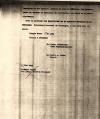
|
4.
22 March 1931.
Patrol Report,
2nd Lt. Leonard Curcey, El Gallo,
to Col. Marston, Bluefields, p. 4.
"Recibimos de don
Laureana Newball la suma de C$300.00,
tres cientos pesos de Cordoba en
articulos de mercaderias que tenia en su
establecimiento. ¶ Todo lo recibido fue
distribuido en el ejercito Defensor de
la Soberania Nacional de Nicaragua, y
que esta bajo mi mando. ¶ Tungla Marzo
1o. de 1931. ¶ Patria y Libertad ¶ /s/
Pedro Altamirano ¶ Jefe Expedicionarios
¶ /s/ Pedro A. Irias ¶ P.A.I."
|
|
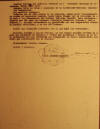
|
25 March
1931.
Orders from Gen.
A. C. Sandino, Cuartel del EDSNN.
Señores Jefes de Reten y Escalones de la
Cordillera 'Emiliano Blandon.'
"Sus
Campamentos. Mis Queridos hermanos:
Ruégoles que al sólo recibo de la
presente, hagan salir violentamente un
correo al siguiente Escalón, hasta hacer
llegar con la velocidad de un rayo a los
Campamentos del hermano Emiliano
Blandon, esas correspndencias que van
para los hermanos Generales Francisco
Estrada y Carlos Salgado P., quienes
actualmente se encuentrán con sus
respectivas fuerzas en aquella
cordillera, y se les dá órdenes. Confío
que cumplirán fielmente con lo que aqui
les encomienda. Nuestras fuerzas a que
me refiero, no han tenido ningúna
novedad en la gira que efectuaron al
interior y vienen muy contentos y llenos
de un vivo entusiasmo por los triunfos
que alcanzaron en varios sangrientos
combates que sostuvieron con el enemigo.
Sinceramente vuestro hermano. PATRIA Y
LIBERTAD /s/ A. C. Sandino"
[original document with seal.
NA127/38/18]
|
|

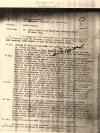
|
28 March
1931.
Patrol Report,
Lt. L. Curcey, La Cruz, District
of Rio Grande, to Col. John Marston,
Bluefields (two images), p. 1.
"GUARDIA NACIONAL
DISTRICT OF RIO GRANDE LA CRUZ NICARAGUA
¶ 28 March 1931 ¶ From: District
Commander. ¶ To: The Department
Commander, GN, Bluefields. ¶ Subject:
Patrol Report. ¶ Reference: (a) Verbal
Orders from Department Commander dated
23 March 1931. ¶ 1. In compliance with
reference (a) a patrol consisting of (1)
one Officer and nine (9) enlisted
guardias cleared El Gallo at or about
1400 March 25, 1931 Events of each day
are set forth below:-- ¶ 23 Mar. Cleared
EL GALLO for San Pedro and Hamlets via
Rio Grande River by PitPan at 1400.
Arrived at Pal Punta at 1900. Natives on
way up had not seen any sign of
organized bandits but reports and rumors
had excited them very much and very glad
to see Guardia. ¶ 24 Mar. Cleared
Palpunta at 0550 and arrived at Aula
Aula Rio Grande River at 1600. Natives
rather nervous but had seen no movements
of organized bandits. At Salutara about
a league below Aula Aula I received
information from one Reducindo Mendoza,
16 year old Sumo Indian that While at
Wani on or about February 28, 1931,
Pedrone and his band had held him for a
day and ordered him to get some mules to
be used as pack animals to carry away
loot, he started after his mission but
run away reaching Salutara on or about
16 March 1931 and gave his reason for
running away as wanting nothing to do
with Bandits. Juez de Mesta there Ramon
Rizo spoke well of him and vouches that
he told the truth. This Mendoza boy also
informs me that Pedron and his bandits
had said something of leaving for Quepi
and then to the interior. ¶ 25 Mar.
Cleared Aula Aula at 0600 and arrived at
Palpunta at 1800, interrogated all of
the natives there and they disclaim any
knowledge of bandits in and around Pal
Punta. Jiranamo Zelaya who is the
proprietor of a large Finca and live
stock there and claims that rumors had
reached him that they were to come to
Palpunta. But he believed that this
information was merely heresay and not
authentic. He placed no value to this
information because it had come from one
of the Suma Indians in that locality. ¶
26 Mar. Cleared Palpunta at 0530 and
traveled northwest on Tuma obtaining no
information of organized bandits having
been in that District but that a large
group was reported as having crossed the
Tuma river at a point two days above
Palpunta and headed toward Matiguas for
the interior on or about 15 March 1931.
With this informaion I decided that the
Bandit group had no intention of coming
down the river and turned back for our
Headquarters, El Gallo arriving at a
place known as Salutar on the Rio Grande
river, at 1830. Too dangerous to
continue trip. Slept there for the
night. ¶ 27 Mar. Cleared Salutara at
0550 and arrive at El Gallo at 1400. ¶
2. All natives on the river promised to
notify the military authorities
immediately upon any knowledge of armed
Bandits movements. [...]"
|
|
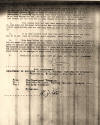
|
28 March
1931.
Patrol Report,
Lt. L. Curcey, La Cruz, District
of Rio Grande, to Col. John Marston,
Bluefields (two images), p. 2.
"[...] 3. Trip
north on Rio Grande was rather hard on
account of the current and the many
falls but worked hard and pushed through
so that we might make contact or get on
trail of bandits, their whereabouts and
concentration. I received information
that their concentration Headquarters is
at Isla Grande but had left there for
the interior. It is also known that
Pedron and his band was at Isla Grande
on or about March 6, 193. ¶ 4. Trip
coming down was very easy excepting
unloading our provisions at Aula Aula
and Salutara Falls which are considered
very treacherous. Current helped
considerably and cut our trip down in
half of the time it took going up. ¶ 5.
It is very evident that they are short
of ammunition and their aim is to get
some by hitting small outposts under
Guardia control. ¶ 6. This Suma Indian
boy Mendoza also informs me that many of
Pedron’s men are armed with shotguns and
that during the time he was detained by
this group he noticed two men counting
ammunition and noticed that there was
about 300 hundred rounds between them
which I judge was to impress the boy
that they had plenty of ammunition but
truthfully only had this 300 rounds for
the entire group which is an average of
about three to five rounds per man in
the group. ¶ 7. Conditions in the upper
river are bad and fever very prevalent.
¶ (signed) L. Curcey ¶ 1st. endorsement.
¶ DEPARTMENT OF SOUTHERN
BLUEFIELDS,GUARDIA NACIONAL DE
NICARAGUA. ¶ Bluefields, Nicaragua. 6th.
April 1931.¶ From: The Department
Commander. ¶ To: The Jefe Director,
Guardia Nacional, Managua, Nic., ¶ Via:
The Area Commander. ¶ 1. Forwarded ¶
(signed) W. J. STONE"
|
|
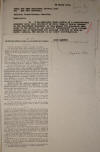
|
28 March
1931.
Revolutionary Circular. Report by
Col. John
Marston, Bluefields, to Jefe
Director GN, on revolutionary circular
in Bluefields & Puerto Cabezas, "Vaticinio
Que Acerca la Hora de la Revancha de Un
Pueblo".
"28 March, 1931.
¶ From: The Area Commander, Eastern Area
¶ To: The Jefe Director, ¶ Subject:
Revolutionary circular.¶ Enclosures, ¶
1. I am enclosing three copies of a
revolutionary circular which were
delivered by Julio Vega of Puerto
Cabezas to the Department Commander in
that place. The circulars were given to
the master of the schooner “Emperatriz”
by an alleged unknown man in Bluefields
for personal delivery to Vega in Puerto
Cabezas. The matter is now under
investigation. ¶ JOHN MARSTON ¶
VATICINIO QUE
ACERCA LA HORA DE LA REVANCHA DE UN
PUEBLO ¶ Se toma lo que sigue del diario
“Excelsior”, de Mexico: ¶ “ El doctor
Max Hanff, cuyas predicciones acerca de
las revoluciones en los paises
sudamericanos y acerca de las
catastrofes naturales en Inglaterra y en
otras partes, SE HAN CUMPLIDO EN FORMA
QUE HA SORPRENDIDO AL MUNDO, formula
nuevos vaticinios. ¶ “El distinguido
medico aleman fue enrevistado ayer por
nosotros. Se manifestaba satisfecho de
que se hubieran relizado caso CON
EXACTITUD MATEMATICA, los diversos
pronosticos hechos por conducto de
“Excelsior”. Nos dijo que su vaticinio
con respecto al Brasil, se ha cumplido
asombrosamente. Igualmente el tremendo
huracan que azoto la costa de Inglaterra
receintemente, FUE ANUNCIADO POR EL
DESDE EL MES DE JUNIO. ¶ “Lo
interrogamos sobre los sucesos que haya
podido derivar de la Cabalistica en los
ultimos dias, y nos declara lo siguiene:
¶ “El ano proximo (1931) HABRA
DIFERENTES REVUELTAS EN LOS ESTADOS
UNIDOS DEL NORTE. El parlamento de la
Union Americana sera disuelto y las
relaciones de los Estados Unidos con
Francia, seran muy tirantes. El numero
de los desocupados aumentara en forma
gigantesca en los Esados Unidos y
ocurriran muchas quiebas y “cracks”
financieros , que causaran la ruina de
numerosos bancos y afectaran las
condiciones economica de Mexico. ¶
“DENTRO DE MUY BREVES MESES ESTALLARA LA
REVOLUCION EN CENTRO AMERICA.
Posiblemene Honduras y Costa Rica sean
los primeros paises que se vean
envueltos por ella. ¶ “Adopta una
actitud meditativa el sabio aleman y
agrega: “Mis studios me permiten afirmar
que los Estados Unidos TENDRAN
CONFLICTOS CON ARGENTINA, BRASIL o
alguno de los mas importantes paises de
la America del Sur. ¶ “En Cuba hay
descontento entre los militares y si hoy
el gobierno ha logrado aparentemente
dominar la situacion, en marzo o en
abril del proximo ano sera tal la
agitacion que se puede dar por seguro
que caera el regimen de Machado. ¶ “Yo
sigo sosteniendo—concluye—que la nueva
Guerra mundial, mas cruenta que la de
1914, surgira a fines de 1931 o a mas
tardar en los primeros meses de 1932.” ¶
Para el pueblo nicaraguense; ese pueblo
que esta sufriendo el flagelo de una
situacion ignominiosa y desesperante,
como no tiene paralelo en su historia y
a la que lo han llevado sus falsos
apostoles de los dos partidos
cavernarios que se disputan la pitanza
del poder: a ese pueblo le llega el eco
de esa profecia, que abre las puertas de
la esperanza de su reivindicacion en una
justiciera revancha que, al para que lo
restituya en su reputacion hoy
vilipendida, lo ponga en condiciones de
castiar a esos falso apostoles
ahorcandolos sin conmiseracion en los
arboles de las plazas publicas, ya que
por cruel que parezca esta expiacion, ES
LA UNICA QUE CABE, dada la magnitud del
dano y las proyecciones del delito y LA
UNICA TAMBIEN QUE ESTA EN CONSONANCIA
CON LA MASCULINIDAD DE UN PUEBLO
CONSCIENTE. ¶ Que asi sea, o que el
pueblo nicaraguense continue en su
esclavitud ante quienes (primero los
jefes conservadores y despues los jefes
liberals) le han entregado al extranjero
como se entrega un hato para que reciba
palos, puntapies, bofetadas y todo
genero de atropellos inicuos, hasta la
misma muerte. ¶ El unico remedio para
Nicaragua esta en la horca en cada
poblacion y para cada politico que en
alguna forma haya propiciado o este
propiciando la ocupacion de este pais
por la fuerza armada yanqui. ¶ El yanqui
se va a ir pronto y la “Guardia
Nacional” va a ser reducida, y esa sera
la hora de que cada arbol de los parques
de Managua y las otras ciudades, sea
adornado de un senor de esos que ahorco
a su propio pais. ¶ El remedio, pues, va
estar en la mano, en una cuerda ensebada
y en que cada cuatro hombres se
encarguen de cada tarea. ¶ !Entiendes,
lector del pueblo!"
|
|
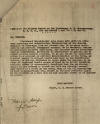
|
31 March
1931.
Fitness Report on 1st Lt. E. E.
Shaughnessey, USMC, for period 1 Oct
1930 - 31 March 1931.
Col. John
Marston, Bluefields, p. 1.
(Source: John
Marston Papers, Virginia Military
Institute, Lexington VA).
|
|
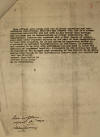
|
31 March
1931.
Fitness Report on 1st Lt. E. E.
Shaughnessey, USMC, for period 1 Oct
1930 - 31 March 1931.
Col. John
Marston, Bluefields, p. 2.
(Source:
John Marston Papers, Virginia Military
Institute, Lexington VA).
|
|
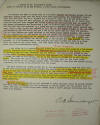
|
31 March
1931.
A Report of Br. Bregenzer's Death Given
at Tuburus by an Eye Witness,
a Sumu Indian
from Musuwas. Br. A.
O. Dannenberger, n.d., Moravian
Archives.
(Undated,
describing events of March 31, written a
week or so afterward.)
|
|
|
|
|
PREVIOUS
NEXT
|
|
|
|
|
|
|
|

